
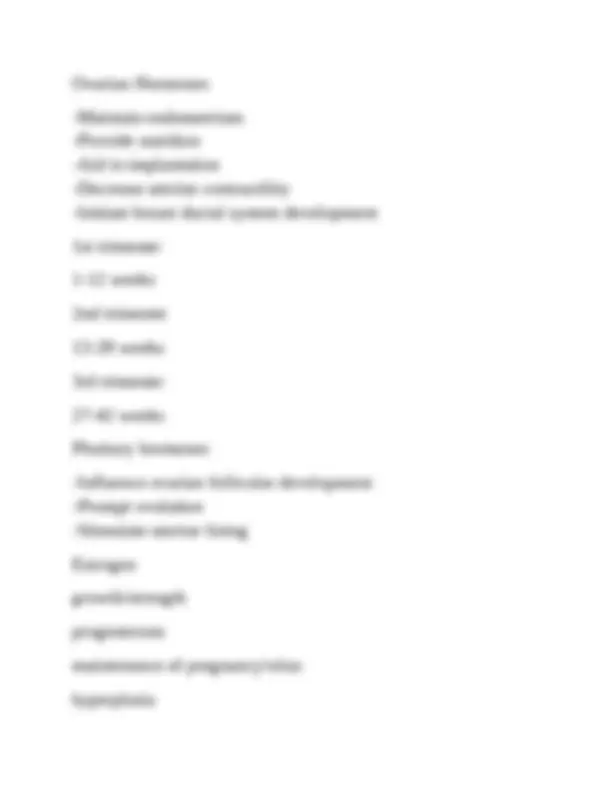
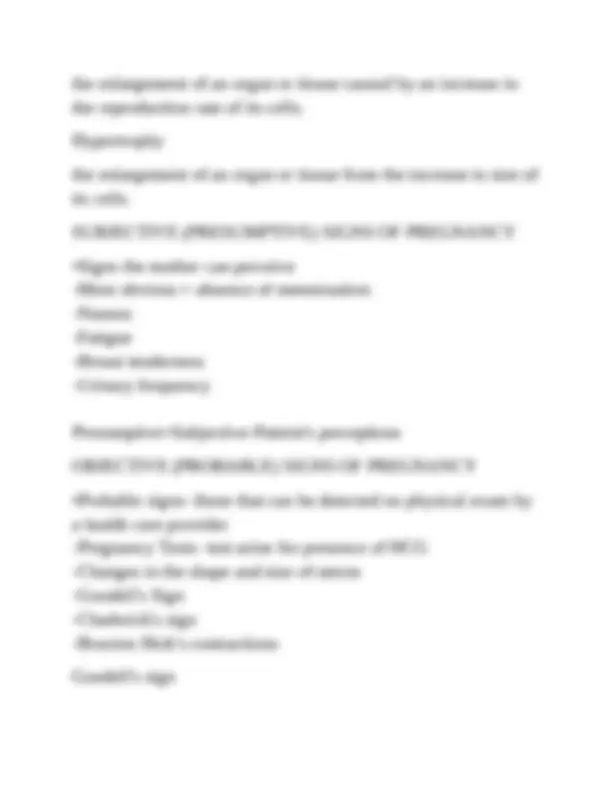
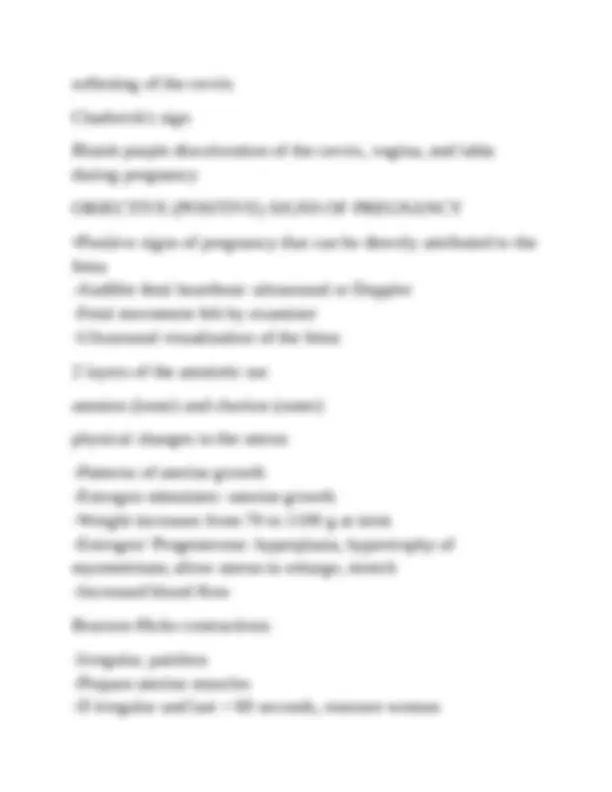
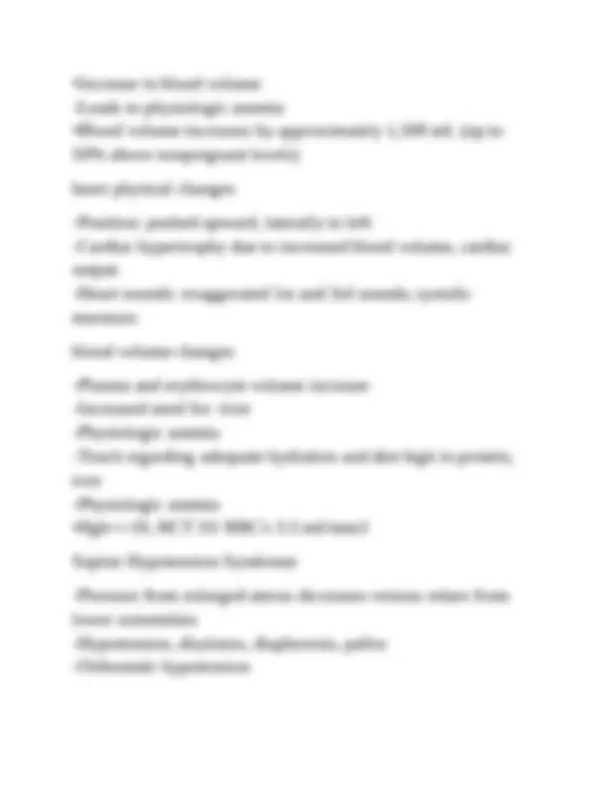
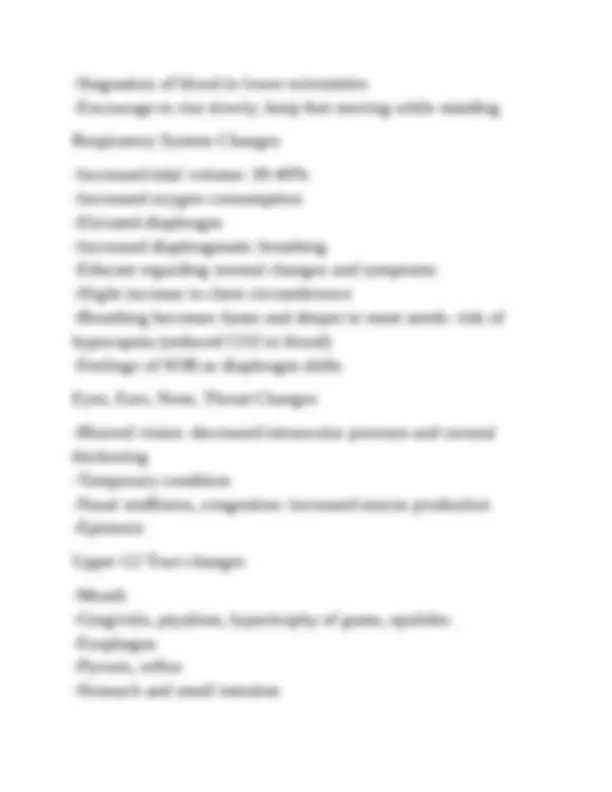
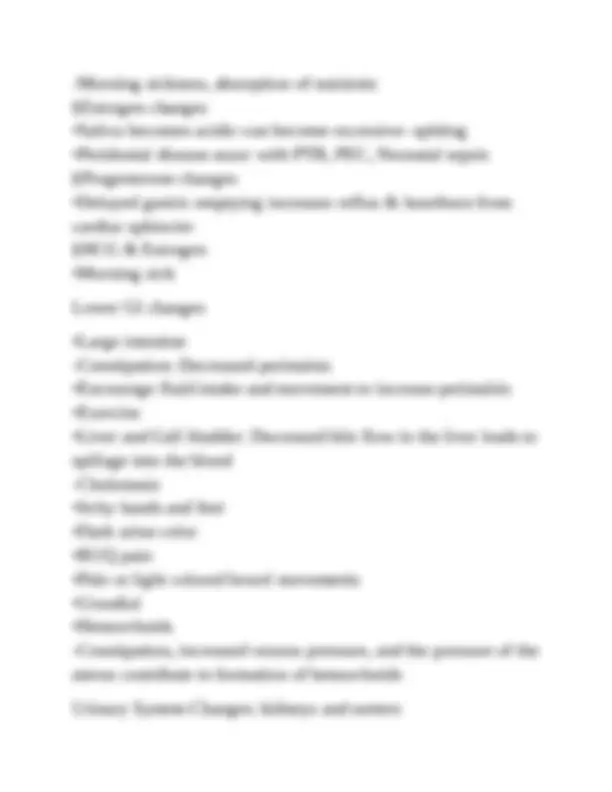
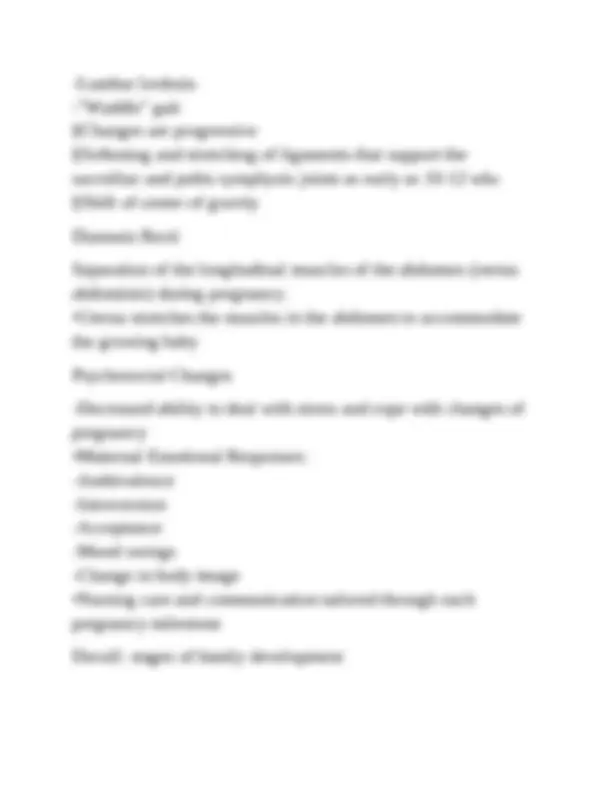
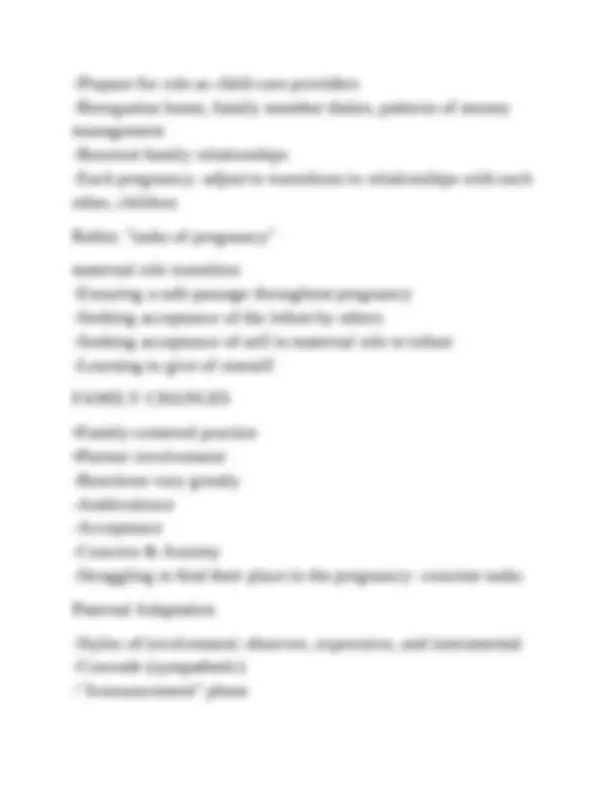
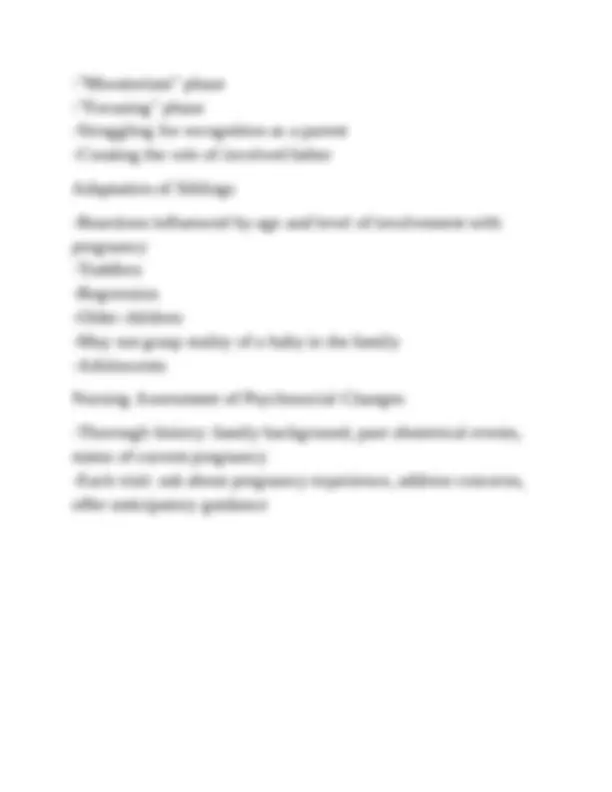


Study with the several resources on Docsity

Earn points by helping other students or get them with a premium plan


Prepare for your exams
Study with the several resources on Docsity

Earn points to download
Earn points by helping other students or get them with a premium plan
Community
Ask the community for help and clear up your study doubts
Discover the best universities in your country according to Docsity users
Free resources
Download our free guides on studying techniques, anxiety management strategies, and thesis advice from Docsity tutors
A comprehensive overview of the physiological changes that occur during pregnancy, focusing on the endocrine, cardiovascular, respiratory, and urinary systems. It includes detailed explanations of various signs and symptoms, along with key hormones and their functions. The document also addresses psychosocial changes and family dynamics during pregnancy. It is a valuable resource for students studying obstetrics, providing a structured approach to understanding the complexities of pregnancy.
Typology: Exams
1 / 15

This page cannot be seen from the preview
Don't miss anything!










Pituitary gland: Prolactin •Anterior pituitary •Targets mammary glands of the breast •Simulates milk production •Response stimulated by suckling •Inhibition by progesterone removed with delivery of placenta Urinary System Changes: Bladder -Pressure on pelvic floor muscles- urge to urinate more -Stress incontinence -Increase incidence of UTI's Extremities -Increased fibrinogen volume -Stasis of blood in lower extremities: risk for varicose veins and venous thrombosis -Encourage daily walks to enhance circulation, improve intestinal peristalsis -Decreased peripheral resistance is from progesterone -Decreased venous return due to pressure from size of uterus on pelvic veins Two primary functions of the ovaries include:
•The development and release of the ovum •Secretion of the hormones estrogen and progesterone Follicular phase: •Day 1 of menstrual cycle to ovulation-variable stage •Estrogen dominant phase -The ovarian cycle consists of three phases: •Follicular phase •Ovulation •Luteal Phase •Follicular phase •Ovulation •Luteal Phase §Ovulation: •Triggered by LH surge •Typically day 14 §Luteal phase: •Starts at ovulation and ends with menses- stable stage 14 day •Progesterone dominant phase CORPUS LUTEUM A hormone-secreting structure that develops in an ovary after an ovum has been discharged but degenerates after a few days unless pregnancy has begun. Corpus luteum maintains pregnancy until the placenta is active
the enlargement of an organ or tissue caused by an increase in the reproduction rate of its cells. Hypertrophy the enlargement of an organ or tissue from the increase in size of its cells. SUBJECTIVE (PRESUMPTIVE) SIGNS OF PREGNANCY •Signs the mother can perceive -Most obvious = absence of menstruation -Nausea -Fatigue -Breast tenderness -Urinary frequency Presumptive=Subjective-Patient's perceptions OBJECTIVE (PROBABLE) SIGNS OF PREGNANCY •Probable signs- those that can be detected on physical exam by a health care provider -Pregnancy Tests- test urine for presence of HCG -Changes in the shape and size of uterus -Goodell's Sign -Chadwick's sign -Braxton Hick's contractions Goodell's sign
softening of the cervix Chadwick's sign Bluish purple discoloration of the cervix, vagina, and labia during pregnancy OBJECTIVE (POSITIVE) SIGNS OF PREGNANCY •Positive signs of pregnancy that can be directly attributed to the fetus -Audible fetal heartbeat- ultrasound or Doppler -Fetal movement felt by examiner -Ultrasound visualization of the fetus 2 layers of the amniotic sac amnion (inner) and chorion (outer) physical changes in the uterus -Patterns of uterine growth -Estrogen stimulates -uterine growth -Weight increases from 70 to 1100 g at term -Estrogen/ Progesterone: hyperplasia, hypertrophy of myometrium; allow uterus to enlarge, stretch -Increased blood flow Braxton-Hicks contractions -Irregular, painless -Prepare uterine muscles -If irregular and last < 60 seconds, reassure woman
Hyperpigmentation Chloasma- "pregnancy mask" skin discoloration on the face Linea nigra Cutaneous vascular changes -Striae gravidarum -Angiomas -Palmar erythema Neurological System Changes -Decreased attention span -Poor concentration:Estrogen correlated to diminished memory, attention and processing -Memory lapses -Carpal tunnel syndrome:suppression of median nerve from tunnel narrowing related to edema and increased fluid vol -Syncope -Sciatica -Anticipatory guidance regarding changes CARDIOVASCULAR SYSTEM CHANGES •Occur early to meet the demands of the enlarging uterus and the placenta for more blood and oxygen •Increase in heart rate (25%) •Increase in cardiac output (30-50%) •Decrease in peripheral resistance -blood pressure initially decreased in early pregnancy
•Increase in blood volume -Leads to physiologic anemia •Blood volume increases by approximately 1,500 mL (up to 50% above nonpregnant levels) heart physical changes -Position: pushed upward, laterally to left -Cardiac hypertrophy due to increased blood volume, cardiac output -Heart sounds: exaggerated 1st and 3rd sounds; systolic murmurs blood volume changes -Plasma and erythrocyte volume increase -Increased need for -iron -Physiologic anemia -Teach regarding adequate hydration and diet high in protein, iron -Physiologic anemia •Hgb<=10, HCT 33/ RBC's 3.5 mil/mm Supine Hypotension Syndrome -Pressure from enlarged uterus decreases venous return from lower extremities -Hypotension, dizziness, diaphoresis, pallor -Orthostatic hypotension
-Morning sickness, absorption of nutrients §Estrogen changes •Saliva becomes acidic-can become excessive- spitting •Peridontal disease assoc with PTB, PEC, Neonatal sepsis §Progesterone changes •Delayed gastric emptying increases reflux & heartburn from cardiac sphincter §HCG & Estrogen •Morning sick Lower GI changes •Large intestine -Constipation: Decreased peristalsis •Encourage fluid intake and movement to increase peristalsis •Exercise •Liver and Gall bladder: Decreased bile flow in the liver leads to spillage into the blood -Cholestasis •Itchy hands and feet •Dark urine color •RUQ pain •Pale or light colored bowel movements •Ursodiol •Hemorrhoids -Constipation, increased venous pressure, and the pressure of the uterus contribute to formation of hemorrhoids Urinary System Changes: kidneys and ureters
•Structural changes -Dilation of the renal pelvis -Kidneys enlarge -Ureters elongate and widen •Functional changes -Increased GFR §Increased blood flow and work load to help with elimination needs, maintain electrolyte balance, and BP. §GFRàincreased urination
-Lumbar lordosis -"Waddle" gait §Changes are progressive §Softening and stretching of ligaments that support the sacroiliac and pubis symphysis joints as early as 10-12 wks §Shift of center of gravity Diastasis Recti Separation of the longitudinal muscles of the abdomen (rectus abdominis) during pregnancy. •Uterus stretches the muscles in the abdomen to accommodate the growing baby Psychosocial Changes -Decreased ability to deal with stress and cope with changes of pregnancy •Maternal Emotional Responses: -Ambivalence -Introversion -Acceptance -Mood swings -Change in body image •Nursing care and communication tailored through each pregnancy milestone Duvall: stages of family development
-Prepare for role as child-care providers -Reorganize home, family member duties, patterns of money management -Reorient family relationships -Each pregnancy: adjust to transitions in relationships with each other, children Rubin: "tasks of pregnancy" maternal role transition -Ensuring a safe passage throughout pregnancy -Seeking acceptance of the infant by others -Seeking acceptance of self in maternal role to infant -Learning to give of oneself FAMILY CHANGES •Family-centered practice •Partner involvement -Reactions vary greatly -Ambivalence -Acceptance -Concern & Anxiety -Struggling to find their place in the pregnancy- concrete tasks Paternal Adaptation -Styles of involvement: observer, expressive, and instrumental -Couvade (sympathetic) -"Announcement" phase